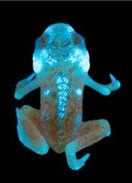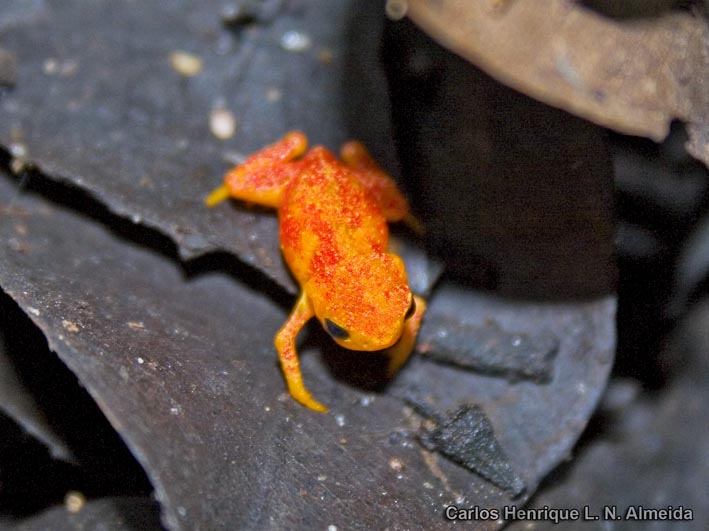- Introduction: A Tiny Marvel of Nature
- Taxonomy and Classification: Defining a Rare Discovery
- Natural Habitat: Life Amidst the Atlantic Rainforest Mist
- Physical Characteristics: Vibrant Warning Signals in Miniature Form
- Behavior and Life Cycle: Mastering the Hidden Life
- Ecological Role: Small in Size, Mighty in Impact
- Threats and Conservation Status: Urgency in Protecting a Tiny Ambassador
- Cultural and Scientific Significance: More than Just a Frog
- Conclusion: A Call to Action for Biodiversity Stewardship
Introduction: A Tiny Marvel of Nature#
Hidden amidst the dense leaf litter and vibrant moss carpets of Brazil’s lush Atlantic Rainforest lives a creature so petite and vibrant, it calls to mind sparkling gems rather than an amphibian species. This enchantingly small frog is none other than Brachycephalus pitanga, a species whose very discovery continues to captivate scientists, nature enthusiasts, and conservationists alike. Named after the vibrant Brazilian pitanga fruit due to its brilliant color, this charming tiny frog has quickly become an ambassador for biodiversity preservation in one of the world’s richest yet most threatened ecosystems.
Despite its diminutive size—barely larger than a fingernail—Brachycephalus pitanga embodies the extraordinary adaptability of life. With striking coloration that serves as both a warning to predators and a distinct visual allure, this frog species provides insights into evolutionary biology and underscores the urgency of environmental stewardship. Join us on a journey deep into the foliage of Brazil’s Atlantic Rainforest to intimately experience the captivating life of this miniature natural wonder.
Taxonomy and Classification: Defining a Rare Discovery#
The species Brachycephalus pitanga falls within the family Brachycephalidae, a lineage commonly known as pumpkin toadlets due to their rounded bodies and vivid coloration. Officially described in 2015 by scientists Luiz Ribeiro and colleagues, this recent addition to the ever-growing biodiversity charts represents continued evolutionary divergence within the genus Brachycephalus. Part of an intriguing genus composed of numerous distinct and geographically isolated species, Brachycephalus pitanga showcases the intricate results of evolution in isolated mountainous terrains.
Its closest relatives share striking similarities—exuberant colors and miniature sizes—but distinctive morphological traits, subtle differences in coloration hues, dermal textures, and skeletal structures have firmly established B. pitanga as its own remarkable entity. The discovery of such delicate diversity highlights the ongoing mystery and untapped potential of Earth’s most secluded habitats.
Natural Habitat: Life Amidst the Atlantic Rainforest Mist#
Endemic exclusively to Brazil’s southern Atlantic Forest biome, Brachycephalus pitanga is a highly specialized inhabitant of mountainous “sky island” ecosystems. Found at elevations above 900 meters, their tiny frame is perfectly suited to the humid, cool microclimates of montane cloud forests. This frog prefers the shady, moist environment brought about by dense forest canopies, thriving on thick leaf litter or nestled among patches of damp moss that retain perpetual moisture.
A Delicate Balance: Adaptation to Hospitable Isolation#
The factors that make these mountaintops so rich in biodiversity—frequent mist, steady temperatures, and lush vegetation—also make them uniquely fragile. Interestingly, the fragmented nature of these habitats has shaped these frogs’ evolutionary path, isolating small populations from neighboring cousins. Such insular conditions promote the rapid speciation evidenced in Brachycephalus, resulting in distinct pockets of biodiversity. It’s a testament to the finely tuned balance between adaptability and vulnerability—one disturbed, unfortunately, by environmental degradation.
Physical Characteristics: Vibrant Warning Signals in Miniature Form#
More striking perhaps than its mountain isolation is the mesmerizing appearance of Brachycephalus pitanga. Adults measure just seven to ten millimeters, making them among the world’s smallest known amphibians. But their lack of size is compensated by a vivid coloration that acts as a vital survival mechanism.
The frog’s vibrant reddish-orange body, reminiscent of ripe pitanga fruit (Eugenia uniflora), is further highlighted by irregular patches of vibrant yellows and distinct spots of deeper reds. This striking coloration is known as aposematic signaling—a powerful evolutionary adaptation that alerts potential predators to toxins or unpleasant tastes contained within the frog’s skin secretions. Hidden among damp foliage, the frog resembles a brightly colored jewel, yet the colors boldly communicate “danger” to hungry birds or mammals scanning the forest floor for prey.
In addition, its skeleton possesses reduced ossification, meaning bones remain partially undeveloped or soft—a phenomenon common among tiny amphibians due to biological constraints. This skeletal trait aids amphibians of extreme small size, reducing overall weight and possibly allowing greater flexibility and efficiency in navigating their lush terrain.
Behavior and Life Cycle: Mastering the Hidden Life#
Observing Brachycephalus pitanga‘s behavior requires patience and attentive eyes, as the tiny amphibian spends its life subtly maneuvering through dense vegetation or quietly concealed beneath leaf litter. Primarily diurnal, these frogs actively forage during daylight hours, capturing minute insects, mites, and arthropods that populate their moist microhabitats. Their approach to hunting is fascinating—the frogs rely on stealth, slowly creeping closer until a swift, short leap can secure the meal.
Mating Rituals and Reproductive Wonders#
The rainy season signals breeding time for this tiny marvel. Male pitanga frogs court females through subtle calls—not loud croaks, but gentle, high-pitched chirps audible only at close distances. These delicate vocalizations gather interested females, leading to mating pairs gently depositing clusters of eggs hidden securely beneath leaf litter or within damp mosses. Intriguingly, this species exhibits direct development: eggs hatch directly into tiny froglets rather than undergoing a free-swimming tadpole stage.
This evolutionary adaptation negates the necessity for standing water, ensuring their survival even in dryer montane environments. The absence of an aquatic stage provides precious survival advantages—reducing exposure to aquatic predators and limiting the need for extensive water bodies—perfectly reflecting adaptation to their montane home.
Ecological Role: Small in Size, Mighty in Impact#
Brachycephalus pitanga plays a significant role in maintaining ecological balance within its complex rainforest ecosystem. As specialized micro-predators, these frogs regulate insect and mite populations, indirectly influencing plant pollination and seed dispersal by controlling herbivorous insects that could otherwise impact vegetation.
Moreover, as prey, they serve as an important dietary resource for certain predators, including specialized bird species and large invertebrates. Perhaps even more tellingly, these miniature amphibians also function effectively as indicator species. The delicate balance of moisture, temperature, and habitat integrity needed to support them means that their presence—or conspicuous absence—is a reliable barometer of overall ecosystem health.
Threats and Conservation Status: Urgency in Protecting a Tiny Ambassador#
Today, Brachycephalus pitanga faces mounting threats, notably from habitat fragmentation, deforestation, agricultural expansion, and climate change impacts. Though not yet extensively assessed by the International Union for Conservation of Nature (IUCN), conservation biologists urge that their already narrow and specialized habitats put this species at significant risk of severe decline.
Fortunately, organizations and local conservation efforts have recognized the vital importance of these unique mountaintop ecosystems. Protected conservation corridors, reforestation initiatives, and sustainable land-use practices are all critical measures advocated by researchers and environmentalists to ensure the survival of Brachycephalus pitanga, and by extension, the intricate biodiversity it represents.
Cultural and Scientific Significance: More than Just a Frog#
Locally, the pitanga frog is affectionately recognized for its jewel-like beauty, admired by area residents who proudly identify it as a symbol of natural richness in southern Brazil’s mountainous landscapes. Scientifically, its recent discovery underscores the ongoing wealth of untapped biological knowledge hidden within Brazilian ecosystems, highlighting the fundamental importance of biodiversity research, protection, and educational outreach.
Conclusion: A Call to Action for Biodiversity Stewardship#
The tiny yet extraordinary Brachycephalus pitanga reminds us that profound ecological value often resides in overlooked wonders. Its fascinating life story beckons humanity to deepen our collective appreciation and stewardship of natural habitats. By supporting wildlife conservation initiatives, spreading awareness, and advocating for forest preservation, each of us ensures that species like this captivating amphibian will thrive for future generations, preserving the incredible biodiversity legacy that enriches our world.














